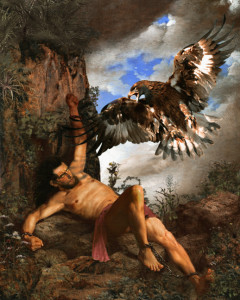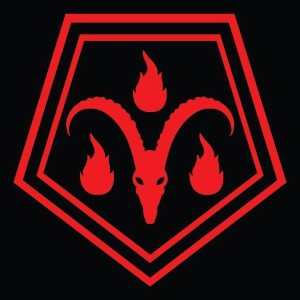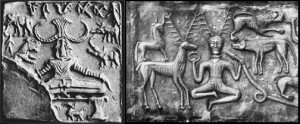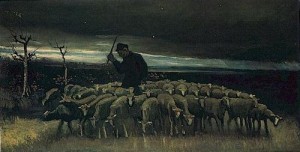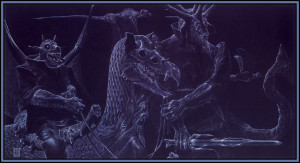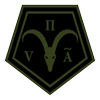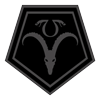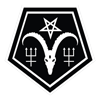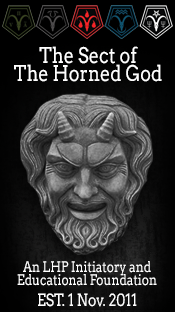Prometheus

by Thomas LeRoy, Founder of The Sect of the Horned God
“One thing that comes out in myths is that at the bottom of the abyss comes the voice of salvation. The black moment is the moment when the real message of transformation is going to come. At the darkest moment comes the light.”
— Joseph Campbell
What connection does Prometheus have to the left-hand path? In Greek mythology, Prometheus (whose name means “the one with foreknowledge”) had a reputation of being something of a trickster, one with a strong rebellious nature. His role was to stir up the existing order and not to bolster the power of Zeus, but to question it. In his book, “Lords of the Left-Hand Path” by Stephen Flowers, he states, “In the history of the kind of thought we are calling left-hand path in the West, it is difficult to overestimate the importance of the myth of Prometheus.”
To get an idea of the nature of Prometheus, we need to go back to the Greek myths themselves. The Titan Prometheus was one of the ringleaders in the battle between the Titans and the Olympian gods, led by Zeus. The goal was to gain control of the heavens. Prometheus switched sides, though, and supported the victorious Olympians when the Titans would not follow his advice to use trickery in the battle.
Eventually Prometheus was given the task by Zeus to create Man. He shaped Man out of mud, and Athena breathed life into his clay figure. Prometheus had assigned his brother Epimetheus (whose name means “afterthought”) the task of giving the creatures of the earth their various qualities, such as swiftness, cunning, strength, fur, and wings. Unfortunately, by the time he got to Man Epimetheus had given all the good qualities out and there were none left. So Prometheus decided to make Man stand upright as the gods did and, feeling sorry for Man’s weak and naked state, Prometheus raided the workshop of Hephaistos and Athena on Mt. Olympus and stole fire.
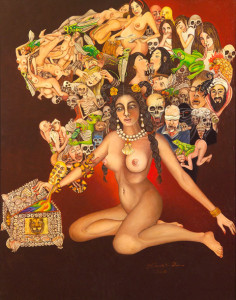
Partially with revenge in mind, Zeus sent Epimetheus a gift of the first woman, Pandora, who like Eve was blamed for causing all the evils humanity has had to suffer. Along with the curious woman, Zeus sent a closed box, telling Epimetheus it was not to be opened. Naturally Epimetheus gave the box to Pandora and, out of curiosity, she opened it. Out flew all the evils and plagues of the world: sorrow, disease, pestilence, war, etc. The only thing that remained in the box was hope.
Zeus, still angry with Prometheus for the theft of fire, sent his servants, Force and Violence, to seize the Titan and take him to the Caucasus Mountains where he would be chained to a rock with unbreakable adamanite chains. Here he was tormented by a giant eagle tearing at his liver. To add to the torment, the liver re-grew every night and the eagle returned each day to perpetually torture Prometheus.
But Zeus gave Prometheus a chance out of this predicament if he met two conditions. The first was that an immortal must volunteer to die for Prometheus, and the second was that a mortal must kill the eagle and unchain him. Eventually, Chiron the Centaur agreed to die for him and Heracles killed the eagle and unbound him.
Because of certain rebellious qualities, Prometheus has similarities to the Christian interpertation of Satan. In the book, “Lucifer and Prometheus” by R.J. Zwi Werblowsky, it is argued that the Satan of John Milton’s Paradise Lost is a strangely appealing character because of the attributes he shares with Prometheus. The book also points out the essential ambiguity of Prometheus and his dual Christ-like/Satanic nature as developed in the Christian tradition. Werblowsky also uses the terminology of Carl Jung in examining “mythological projections of the human psyche”, though he emphasizes that he is not interested in the concept of the archetype in the strict Jungian sense. Rather, he sees the myth of figures such as Satan and Prometheus as expressing “the shortcomings … of the world as conceived by the human soul.”
The myth of Prometheus is not simply a tale explaining how humans received the essential tool called fire, it instead metaphorically relates how we came upon that divine gift, that quality of the gods called intellect. The left-hand path is the individual’s quest to achieve divine power, or self-deification. And needed to journey this path is our own personal light. Without that gift from Prometheus we would be nothing more than beasts, naked on a path of ignorance, searching, crawling blindly toward any distant light.
The Sigil Project
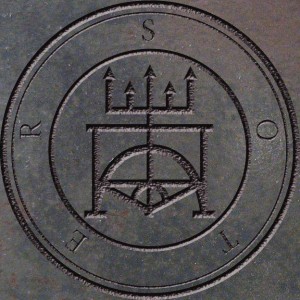
by Thomas LeRoy, Founder of The Sect of the Horned God
Demons, angels, gods and monsters originate from within. They are aspects of our character. According to the psychologist, Carl Gustav Jung, the subconscious and what goes on therein, can not be fully explained in words, for the lower reaches of the psyche does not communicate in words, it speaks to us in symbols and metaphors. So in the dark depths of the subconscious our personal demon, or “daemon”, resides. Aleister Crowley had Aiwass, Jung had Philemon. These are special metaphors that relay messages to us, conduits between our conscious mind and the deeper layers of the subconscious, all the way down into collective unconscious.
For years I have had dreams of a silhouetted “hooded” figure standing at the foot of my bed. I would find myself sitting up, heart racing, thinking it was real, but always the dream would end and the strange specter would vanish. In the early part of 2015 I was sick with the flu and had a very vivid, feverish dream. I dreamt I was watching a documentary on a rather large television. On the screen I could see a rocky hill-side, cliffs and great boulders, the sky the color of slate. And there among the rocks was a battered wooden cart pulled by a team of six dead goats, re-animated, rotted flesh hanging, eyes glazed, mouths stretched tight in a perpetual grin of malice. And in the back of the cart stood a tall figure in a robe of gray. Protruding from within the robe where a neck should be was a wrist, and at the end of the wrist was a large claw-like hand, or talon, clutching a head, the claws like a hood around the head. And upon that head was a face, neither male nor female, blank and serene, its eyes and mouth were closed, and stayed closed even as that androgynous being spoke. For some unknown reason I knew this was that same entity that had visited me over and over, but this time I could see it in its full glory. As I marveled at this, a name came on the screen: “SOTER”.
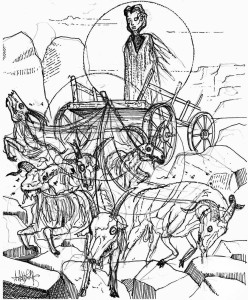
A couple of weeks after that dream I was listening to a podcast on gnostic philosophy. Being interviewed was a women who had written a book on the Greek god Dionysus, and as she described the god of “wine and revelry”, she used the ancient Greek word for savior: soter! I felt my brain flip in my skull when I heard that word. The podcast was recorded so I played it over and over again. I had heard it correctly. The word was soter. Not long after that I had another dream where I was visited by a certain long dead German dictator. The man with the Chaplinesque mustache was begging me to get in touch with SOTER so that he may ask him for advice. What the fuck was going on? I can only guess that I had read the word soter before and buried it somewhere deep in my subconscious. But now, what was my psyche trying to tell me? While brooding over this conundrum, I came up with an idea. Most use in their ritualistic workings the gods and demons manifested by the subconscious of others from the ancient past. But why play someone else’s music when you can create your own?
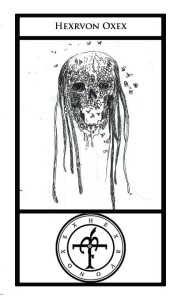
I asked the other members of The Sect to visualize their own special entity, that aspect of the subconscious self that comes to them in their dreams and/or visions. Many responded. I then asked them to describe that being — convey its essence — in a single word. That word was then translated into Latin, Greek, or Enochian, and then put through certain Chaos techniques by The Sect’s “Master of Rituals”, The Dark Fool. Over time he converted that word into a sigil. The sigil was handed over to The Sect’s art-director, Anton Wolf, and given it’s final appearance along with a detailed illustration of that “daemon”.
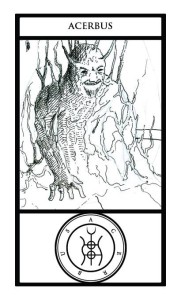
Thus began what is simply called, The Sigil Project. This endeavor has turned out to be more than a simple psychological art project. It has actually helped some of or members to get in touch with aspects of themselves they have either shunned, or repressed. Their deeper selves now have a face, and a voice. The members that participated have a personal tool, their own song, to utilize in their own personal workings.
Time will tell where this project will lead, but I do know this — it has only just begun.
Azazel
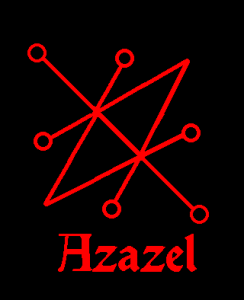
by Thomas LeRoy, Founder of The Sect of the Horned God
“The whole earth has been corrupted through the works that were taught by Azazel: to him ascribe all sin. ”
— 1 Enoch 2:8
Azazel (name said to derive from “azaz” and “el” meaning “Strong one of God”), is the chief of the Se’irim, or goat-demons, who inhabited the desert and to whom most primitive Semitic tribes offered sacrifices. But in the Book of Enoch it states that he was the leader of the fallen angels, and is often identified with Lucifer (the Lightbringer) or Lumiel (‘the light of God’). In other ancient texts, including the Torah, and the Zohar, Azazel was refered to as the “Seed of Lilith”. These texts further hint that Azazel was not the product of Lilith mating with any ordinary man, but rather he was the first-born son resulting from her illicit mating with Semjaza, the leader of a group of fallen angels called Watchers.
In one account in the Book of Enoch, it was Azazel who educated humankind of heavenly secrets that lead them to sin. He taught ancient men metallurgy and how to mine from the earth and use the different metals to forge swords, knives, shields and body armour. To the women he taught the art of making ornaments, rings and necklaces, and how to “beautify their eyelids” with kohl and the use of cosmetic tricks to attract and seduce the opposite sex. From these practices Enoch says there came so much “godlessness” that men and women committed fornication. He also revealed to the people the secrets of witchcraft, thus leading them even further astray. Eventually the angels brought charges upon Azazel and presented him to the Lord for the crime of revealing these heavenly secrets to mankind. Raphael was then assigned to punish Azazel by binding him hand and foot and throwing him into the darkness upon the rocky ground. Here he would remain until the Day of Judgment when he would then be hurled into the fire to be consumed forever.
The apocalyptic writers of Enoch brought Azazel into connection with the Biblical story of the fall of the angels. This growing chasm between God and some of his “sons” is important in understanding the emergence of the Satan character as we know him today. Not only does this division preserve God’s righteousness, it also begins the evolution of a single being to become the antithesis of God in Judeo-Christian mythology.
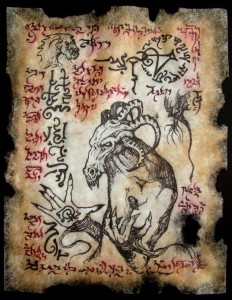
Because of Azazel’s connection to the Se’irim, his name has become synonymous with the word scapegoat. On the 10th day of September, on the feast of the Expiation, it was Jewish custom to draw lots for two goats: one for Yahweh and the other for Azazel. The goat for Yahweh was then sacrificed and its blood served as atonement. With the goat for Azazel, the high priest would place both of his hands on the goat’s head and confess both his sins and the sins of the people. The goat (“scapegoate”) was then led into the desert and set free. Symbolically, the scapegoat took on the sins of the Israelites and removed them.
Thus, Azazel carries upon him the people’s sins. Not unlike a certain Nazarene, another mythological figure from the Middle East.
Satanism and the Eternal Recurrence
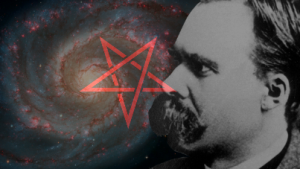
by Thomas LeRoy, Founder of The Sect of the Horned God
“What if some day, or night, a demon were to steal after you into your loneliest loneliness and say to you: “This life as you now live it and have lived it, you will have to live once more and innumerable times more; and there will be nothing new in it, but every pain and every joy and every thought and sigh and everything unutterably small or great in your life will have to return to you, all in the same succession and sequence – even this spider and this moonlight between the trees, and even this moment and I myself. The eternal hourglass of existence is turned upside down again and again, and you with it, speck of dust!
“Would you not throw yourself down and gnash your teeth and curse the demon who spoke thus? Or have you once experienced a tremendous moment when you would have answered him: “You are a god and never have I heard anything more divine.”
–from Nietzsche’s “The Gay Science”
Nietzsche asked this question of his readers back in the 19th century, and now, in the 21st, how would you answer? Does it fill you with dread, or are you pleased with the idea? Is it a blessing or a curse? The demon’s assertion is the frightening possibility that everything that has happened, or will happen, has already occurred and will occur infinitely many more times, without the slightest alteration in detail, living this same life over and over until the end of time. And the image of the demon suggests that such a visitation would be seen as dangerous and unwelcome. Many would be highly unpleased with this notion. Their lives are filled with misery and pain, pain that is, more often than not, self-inflicted. The average Christian, for example, sees pain and suffering as an important part of their existence. Their beliefs hold that we are cursed from birth, and it is our job to live a humble life before the Lord so He may remove that curse, because the here and now is but a transitory phase. Life is simply a preface to an eternity of bliss. Because of this belief, the Christian would find the idea of the eternal recurrence to be horrific. But how would you, the modern Satanist, react to it?
There should be only one answer — with joy!
Satanists, if you are not already living your life to its fullest, then what are you waiting for? Existence itself should be viewed as something to be relished, all the happiness and heartache, pleasure and pain, should be held in the highest regard. You should have a love of fate — amor fati, the affirmation and acceptance of the whole of life. And eternal recurrence is a way to force attention on life exactly as it is. If one could say yes to eternal recurrence, then one could genuinely say yes to life as it is. One way of dealing with this idea, and to achieve a love of fate, according to Nietzsche, was that one must gain freedom from morality — a revaluation of all values:
“To endure the idea of the recurrence one needs: freedom from morality; new means against the fact of pain (pain conceived as a tool, as the father of pleasure; there is no cumulative consciousness of displeasure); the enjoyment of all kinds of uncertainty, experimentalism, as a counterweight to this extreme fatalism; abolition of the concept of necessity; abolition of the ‘will’; abolition of ‘knowledge-in-itself.'”
Nietzsche’s world-view is that of a “Dionysian world of eternally self-creating, eternally self-destroying . . .” The Dionysian attitude toward life is purely artistic, celebrating aesthetic value (even if it has no epistemic value) and rejoicing in the destruction of morality, especially Christian morality. It is an existence always in flux and the counter to the ascetic ideal of self-denial. In this reality the existential truths hold no sway over the individual. Change is the only constant, and with change comes pain. Strength is achieved through this suffering and true joy can come from over-coming (the will to power). Existence is short, and one must craft his or her’s own identity through self-realization and do so without relying on anything transcending that life, such as God or a soul. Your life should be lived without regret, remorse, or guilt, and open to the love of self, others (if found to be worthy of it) and the world in all its manifestations. This view goes beyond nihilism and is the essence of Nietzschean thought.
It is a way of restoring meaning to life — to your life!
Shiva the Destroyer: Lord of the Left-Hand Path
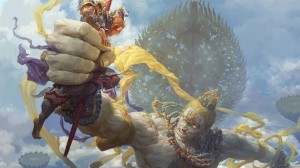
by Thomas LeRoy, Founder of The Sect of the Horned God
There are many mythological gods and entities on the left-hand path. Lord Shiva is but one. Though not always viewed through the lens of the LHP, he is, in some manner, the greatest of these deities.
Shiva is one of the most important gods in the Hindu tradition and, along with Brahma and Vishnu, is one-third of the holy trinity of Hinduism. A deity of great complexity, he is often represented as a lord of love, light and protection. But he also has a darker side. Shiva the Destroyer is the leader of evil spirits, ghosts, vampires, along with being the master of thieves and villains. He destroys the universe at the end of each cycle (every 2,160,000,000 years) which then allows for a new Creation. His destructive powers are often terrible, but they also have a positive side in that destruction usually leads to new and better forms of existence. Shiva destroys in order to create, since death is the medium for rebirth into a new life. It is common to see Shiva depicted with four arms and three eyes. A glance from the third eye in the center of his forehead has the power to destroy anything in creation, including humans and gods. In this destroyer role he often lurks the cremation grounds, a serpent representing Kundalini coiled around his neck, along with a necklace of skulls. And it is not uncommon for him to be accompanied by a band of terrifying demons, hungering for blood.
Shiva seems to have a connection to the deities of Western traditions through an ancient horned god of the Indus Valley, a “proto-Shiva”, called Pashupati. In the Skanda Purana it tells how Pashupati used to find calm in a forest called the “Sleshmantaka” . It was here that he spent time being immersed in “the wilderness of this forest.” Depicted seated in a lotus position surrounded by animals, Pashupati had a striking resemblance to Cernunnos, horned god of the Celts, but there is a 3,000 year old gap, between these two gods (Pashupati dating from about 3,000 B.C.). Is this an example of racial memory, the collective unconscious, or do they both stem from a long forgotten Indo/European horned god? It is a mystery to be pondered, but what is also interesting is Cernunnos has been, over time, transformed into an incarnation of Satan, supreme lord of the Western left-hand path traditions, while Pashupati has morphed into Shiva, lord of the Eastern.
Shiva the Destroyer is the most ancient and powerful of all LHP deities. He is the ultimate adversary, adversarial to those aspects of the self that keep one from progressing upon the path. Shiva and the other beings of a mythological nature are not to be believed as objective truths, nor are they to be shunned as lies. They are to be experienced, experienced within the soul/psyche as meaningful poetry of the subconscious.
To meditate upon the image of Shiva,
to utilize the metaphor, to find calm in the symbol that is the deity,
does not make one a Hindu.
Just as contemplating on the image of Satan, does not make one a Hebrew.
Ovis Aries
by Thomas LeRoy
Those on the left-hand path must be a person of self-worth. Your identity, your worth, should be found in your achievements. You do no find your value in religious faith, or in the herd you move along with. But those without self-worth are more than ready to claim perfection for their nation, religion, race or holy cause. For this type, a cause, any cause, is what’s important. It is very difficult for the person with a sheep-like mentality to find a worth-while purpose in personal self-advancement. The prospect of striving for the good of the individual doesn’t push them to achieve, nor can it evoke in them purposeful dedication. They look on self-interest as something evil; something tainted. Anything undertaken under the auspices of the “self” seems to be without any real purpose. Nothing based in the self can be noble or right. They are rendered guilt-ridden. What they crave is a chance to acquire new elements of pride, confidence, hope, a sense of purpose and worth by an identification with a greater cause, be it religious or otherwise.
The Wanderer heard the sheep before he saw them as he went down the path at night. And It was around a bend in the road, within shards of silver moon-light, that Wanderer saw the Shepherd standing amongst his great flock.
“How much further is it to Hyperborea?” said the Wanderer to the man.
The Shepherd shrugged. “I’ll tell you if you answer a question.”
“I don’t have time for this,” said the Wanderer.
“It will only be one question.”
The Wanderer sighed. “Make it quick.”
The Shepherd smiled. “What do you believe?”
“What?” said the Wanderer.
“What do you believe?” repeated the Shepherd.
The Wanderer thought for a moment, then shook his head. “In truth, I believe in nothing. I either know things, or I don’t. Besides, belief takes up room. I would rather save it for the truth.”
The Shepherd clapped his hands. “Very good. ‘Nothing’ should be the only answer to that question.”
“So,” said the Wanderer, “are you going to answer mine?”
The Shepherd grinned as he stepped to the side, shooing his sheep away. “The answer to your question is this: You will reach Hyperborea when you are ready to reach Hyperborea. But beware, there are many more forks and detours on the path.”
“That’s it?”
The Shepherd shrugged.
“What would have happened if I had given you the wrong answer?”
The Shepherd stared at the Wanderer, then smiled and gestured toward the sheep.”The believers? Lost, they are, and damnation awaits them at the end of their path. The faithful are the worms of the earth. They are the weak of mind and spirit, ever crawling, battered by Life. They have been impaled by the Spear of Belief, bleeding out. Many are waiting to die to become fulfilled. Their souls are empty, their will is gone.”
The Wanderer’s brow grew heavy. “What are you saying?”
“The Shepherd shrugged. “They came to me, asking questions. They thought they were on the path, but they never were. Now, they are my flock, just waiting to be slaughtered; my frightened guests in the abattoir.”
Most people in the United States find solace and/or safety in either religion or in being governed. Those on the political far right, more often than not, find it in the Christian God. While those on the far left long to make government their god, striving for that great collectivist Utopian ideal. Both have dreams of a “glorious future to come” be it here on earth or the after-life. They shout out their bumper-sticker slogans about “freedom”, while both sides are terrified of real freedom. They are unlikely to be happy in a truly free society. True freedom aggravates the sheep. This is because freedom of choice places the blame of failure on the individual. True freedom is dangerous. It’s the ability to reach the highest highs, or plummet to the lowest lows without a safety net.
In truth, the sheep’s innermost desire is for an end to this “free for all.” They want to eliminate the ruthless testing to which they are continually subjected to in a free society.
They long for a shepherd.
Demons
by Thomas LeRoy
Demons are an aspect of the self that reside in the subconscious, that space between the ego and the doorway to the collective unconscious. Demons represent the “dynamic of life”, to quote Joseph Campbell. They are metaphors of certain psychological attributes that those upon the RHP would like to ignore or repress. If utilized correctly, demons can be a positive force in the life of the individual.
There can be no doubt that everyone carries demons, and if not embodied in the individual’s conscious life, the more deadly and wilder the demons become. Most are frightened of their demons, locking them away deep in their subconscious where they run amok.
The Individual was different than the others in his village. He had known this most of his life. He longed to go beyond the walls, but not take that same old path that all seemed to follow. He wanted to hike the trail to the left of the village, the dark path that some whispered led north to Hyperborea, beyond the “North Winds”.
The Individual became aware of his wander-lust while still a youth, living in his father’s home. Once his father aquired six pups. Beautiful creatures, over-zealous with an enthusiasm for existence. His father kept the pups in the cellar, where they slept and defecated on a cold earthen floor, lapped from a rusted pan filled with water, and ate from an old pot that he supplied with scraps from his dinner table. Only when he fed and watered the pups did the man spend any real time with them. And that time was usually spent beating them with a belt to keep them from leaping on him out of the sheer joy of seeing their master. After a time he decided to chain them to a post. He never once cleaned their habitat, and the feedings became less and less frequent until he fed them very rarely.
The months passed, and the pups grew to be filthy, wrathful creatures. But the Individual’s father ignored their howls of rage by going about his mundane existence. But the howling did not cease.
One morning the Individual awoke to a new sound coming from behind the cellar door, the sound of scratching, and chains clanking up and down the steps. The dogs had broken loose from the post. His father grabbed his belt, ready to teach them a lesson.
He opened the door . . .
The Individual found the remains of his father, scattered about like a bloody, broken doll.
And the dogs of wrath were gone.
This was only the first of many occurrences that fed the Individual’s wander-lust.
To allow these otherwise harmless creatures (your demons) to be ignored, there eventually emerges a raging pack. Having a suspicion of this ugly possibility, the average person turns a blind eye to their demonic nature. But if their demons stay repressed and are isolated from the ego, this aspect of the self can never be utilized for the benefit of the self. But one’s demons must neither be repressed nor fully exploited, but through transformation into appropriate channels, brought into balance with the conscious personality. If this is not achieved, if the pit bulls are ignored, the outcome can be most grim.
Your demons should be integrated, not eliminated. This is why it seems that those whom commit the most bizarre and heinous of crimes are not the out-spoken artist with the spike-covered leather jacket and mohawk, but instead the quiet church deacon behind the white picket fence.
Satanism, Symbols and Archetypes
by Thomas LeRoy
Symbols and mythological archetypes are important on the left-hand path, and should be in all Satanic organizations, otherwise you’re simply atheists with an attitude.
Archetypes are universal within our species because many differing configurations of emotion are ubiquitous in the human experience. These images tend to lead to metaphorical structures, which eventually develop into complex representations with emotionally motivating schematic meanings. How does archetypal symbolism come about in the human psyche? Carl Jung believed we were born with them and that they reside in the collective unconscious. He believed that these models, or symbols, are innate, universal and hereditary. Archetypes should function to organize how we experience life. They are neither good nor bad. They simply are. Archetypes are not able to be tamed by society; they live an autonomous existence in their original raw and primitive forms. To most people, with their limited awareness and their many fears, certain archetypes seem good and others seem bad. Most are attracted to the “positive aspects” of the Mother, the Hero, the Sage, but terrified of the Devil, Demons and Serpents.
We on the left-hand path are drawn to those archetypes that survive in the darker reaches. Like Cerberus, they are standing guard over our own personal Underworld. They are sentinels between us and the herd.
Within the Sect, the use of mythological archetypes may vary from person to person. Most Satanic groups use Satan, and only Satan. We also utilize Pan, Cernunnos, Prometheus, Dionysus, Shiva, the choice is that of the initiate. Hence the name “The Sect of the Horned God” and not the “The Sect of Satan”.
These gods are guides to lead the individual through the deeper aspects of the self, through the maelstrom that is the subconscious, and to the door of the collective unconscious, where aspects of these archetypes are recognized. The collective unconscious consists of these primordial images, the most ancient and universal “thought forms” of humanity. Jung pieced together the theory of the collective unconscious when he noticed that some of his less educated patients created delusional images that he found to be analogous to symbolic representations from many religions and mythologies. The link between the dreams, fantasies and drawings of these patients and the symbolic structure of mythologies prompted Jung to speculate about a collective, or shared, origin of symbolic images. The horns and antlers of the Greco/Celtic gods, and the fire of Prometheus would be examples of recognizable universal forms. The horns representing power, the fire knowledge. Together they become what a true Satanist is: a synthesis of strength through personal knowledge.
Hyperborean Transcendence — Evolving Beyond Personal Laws of Limitation
By Jake Block
The Unknown Known
by Anton Szandor LaVey (The Satanic Rituals pp. 219-220)
Despite others’ attempts to identify a certain number with Satan, it will be known than Nine is His number. Nine is the number of the Ego, for it always returns to itself. No matter what is done through the most complex multiplication of Nine by any other number, in the end the final equation nine will stand forth.
The true ages of times are cast in the likeness of Nine, with all cycles obedient to its Law. All matters of terrestrial concern may be evaluated by the infallible resolution of Nine and its offspring. Action and reaction relative to humanity’s tribal needs are contained within successive nine-year periods: the total of both (eighteen years) is called a Working. The beginning and end of each Working is call a Working Year, and each midway point between Working Years displays a zenith of intensity for the Working which has been brought about. Nine eighteen-year Workings equal an Era (162 years). Nine Eras equal an Age (1,458 years), which has been mistakenly called a millennium. Nine Ages equal an Epoch (13,122 years).
Each Age (1,458 years) alternates as Fire or Ice, each differing in the means by which the Control presents its dictum. During the Age of Ice, man is taught to refrain from his pride and retreat from himself; then he will be good. During an Age of Fire, man is taught to indulge himself and to tear himself open and look inside; then he will be good. During an Ice Age, God is above. During a Fire Age, God is beneath. Throughout each Age, big things occur each eighteen years, for the Control must maintain a cycle of action and reaction within the greater cycle of Fire and Ice.
Meaningful and portentous messages are cast forth each eighteen years, and are acted upon for the eighteen years which follow, at the end of which a new statement appears. The Ice Age from which we recently emerged began in the year 508 “A.D.” Just as the Zenith of passion for what each Working has inspired occurs halfway between the Working Years, so the greatest intensity of each Age’s message occurs at its midpoint. Thus in the year 1237 “A.D.” man’s fervor for what the last Ice Age represented had reached its summit. That Age ended in 1966, and the new Age of Fire was born.
The twentieth century has prepared us for the future and the coming of the Age of Fire was well heralded in the last Working Years of the Ice Age. The peoples of the Earth have been touched by the vehicles of 1894, 1912, 1930, and 1948, and communication has been well wrought. The new Satanic Age was born in 1966, and that is why His Church was built.
The infant is learning to walk, and by the first Working Year of his age – that is to say 1984 – he will have steadied his steps, and by the next – 2002 – he will have attained maturity, and his reign will be filled with wisdom, reason and delight.
REGE SATANAS!
AVE, SATANAS!
HAIL, SATAN!
LaVey was fond of saying “Today’s madness is tomorrow’s norm,” meaning that the pendulum of acceptance and rejection swings from acceptance to rejection of fashion, of taste, of value and of law.” Change is the only sure thing, based on human whims and popular prejudice. Think of this passage from the reading, above:
“Each Age (1,458 years) alternates as Fire or Ice, each differing in the means by which the Control presents its dictum. During the Age of Ice, man is taught to refrain from his pride and retreat from himself; then he will be good. During an Age of Fire, man is taught to indulge himself and to tear himself open and look inside; then he will be good. During an Ice Age, God is above. During a Fire Age, God is beneath. Throughout each Age, big things occur each eighteen years, for the Control must maintain a cycle of action and reaction within the greater cycle of Fire and Ice.”
The Control. What is “THE CONTROL?” Is it the societal norm, a consensus of what is right vs what is wrong; a mandated law or contract of limitation in which citizens agree to abide under threat of personal penalty; a holy dictum from an all seeing and all knowing god pronounced from a mountain on tablets of clay, or is it simply man’s personally accepted limitation upon himself?
The answer is in who you ask this question of, because it will change respectively, dependent upon their philosophical, religious, cultural… even socio/economic standing in whatever cultural or societal grouping they may fall within. Which is the true direction and ultimate north star by which man may guide himself through the murky waters of his earthly existence? We go to great lengths to choose who among us will give us this direction, spending millions in national and personal wealth to promote and elevate “the select” to be “the CONTROL,” yet upon doing so, we inevitably (and naturally) come to the conclusion that they are inept at doing their jobs… jobs that WE placed them in positions for, TO CONTROL. We find fault in THEM, but in reality, the failing is invariably with US, as we naively accept that we NEED control, for we are incapable of controlling ourselves. We lack that wisdom. We need supervision.
Left to function under their primitive, emotional and untrained raw selves, most men will simply exist. If you tell him, “eat cake,” and leave a whole, delicious three layer triple chocolate and sugar sprinkled masterpiece in front of him, he will EAT CAKE until it is gone, or until he can no longer stuff his face with another bite, leaving the rest. He has followed the dictum, and now moves on, without the discipline to know that perhaps simply having a piece of cake and saving the rest for later might be in his better interests. He has no responsibility for the cake, and has no idea of consequences. He is simply doing what he does. Eventually SOMEONE gets the idea and learns to conserve, and they pass that message on to others who learn, becoming THE CONTROL by default. This, then, becomes the model that we begin to follow, knowing it and (as we will almost always revert to our primitive natures) resist change to our world because we have no idea of other options available. Fire and Ice. Given personal options and personal responsibilities, attitudes and actions change. Given a law, they become stagnant and simply follow life in rote memory. Here we can fall back on physics and apply it to the human condition (inertia). “Objects in motion tend to stay in motion and objects at rest tend to stay at rest unless acted upon by an external force.”
The Hyperborean mind becomes its own “external force,” in that in analyzing a given situation logically and as dispassionately as possible, a third option might be achieved. So, instead of seeing the cake with an EAT/DON’T EAT control (binary thinking,) one injects a third option of logic. Eat SOME, SAVE FOR LATER. To those with a logical and self-protective mind, this will seem to be simply common sense, but for those coddled into submissive, controllable lassitude, dependent on external control, not so much.
The idea of transcendency fits within the Hyperborean construct. In transcending the traditional limitations of unstructured and undisciplined thought, one can focus more upon what matters. Personal responsibility in all things makes this possible. In the simplistic example of the undisciplined cake eater, simply looking at it as action vs consequence shows that in simply eating, one is satisfying one’s immediate need, but in planning and conserving, one cans satisfy the immediate and long term needs as well. This model can be used in all aspects of one’s life, replacing simple binary thinking with alternatives as needed. The Hyperborean mind doesn’t accept the supernatural “god” or “control” option, but transcends into the supranatural realm of personal deification, in which one decides for themselves logically and with personal responsibility for the actions they take.
OK… now let’s tie this in with the Fire and Ice concept from LaVey’s piece, THE UNKNOWN KNOWN. If we think of ourselves as “X” — the SPOT — and suspend a pendulum above us, holding stationary, this would indicate where we as individuals stand on any given topic. To the left is FULL ACCEPTANCE and to the right is FULL REJECTION of a situation at hand. For the example at hand, the topic could be drug legalization.
Realistically, no one is going to start out as dead neutral on any subject of personal import. I will place myself 3/4 of the way to the FULL REJECTION side of the issue. Someone else might be on the opposite side, 3/4 of the way to FULL ACCEPTANCE. That’s ok. We’re looking for differences. We’re beginning to come to grips with our personal vs societal or cultural conditionings. We are where we are because we have our minds made up, sometimes as a knee-jerk reaction to something we see as abhorrent, and sometimes simply because it is adversarial or contrary to be in opposition of any idea not our own. How then do we act as our own external force to swing the pendulum?
Now, if we see our goal as to make everyone see and think our way, we want that pendulum to swing in our direction, so we will proselytize, we will cajole, we will shame others into thinking that we OBVIOUSLY have the right idea, and that only an idiot would see things differently. We see that it’s better (at least for us) if we stay here, comfortably set in our ways and beliefs. Our opposition is thinking the same way, trying desperately to keep that pendulum moving in the OBVIOUSLY right position, so he’s proselytizing, cajoling and shaming others as well. The result, stalemate… NOBODY WINS. The traditional (red pill/blue pill) option is that one side or the other will bitch, complain, moan and become such a pain in the ass that eventually people will begin to just submit to get some peace. We never really resolve anything… we CAN’T, simply because in matters of personal sovereignty, while we might listen to others, we can only do what is right for ourselves. Stalemate… lip service… constant struggles.
What I’ll call the Hyperborean Solution is to simply refuse to play the game. By using logic and rejecting the emotionality of a question, one can focus on what is important in any issue of choice. In doing so, one brings the positives and the negatives that are presented into personal perspective and one can embrace the pros and cons simply as that, balance… but only as it applies to you. Let it go. It really doesn’t matter on a personal level if person A or B does or does not use drugs. What matters is if YOU do, and if one is truthful to themselves and intellectually honest with themselves, they can evaluate the benefit vs detriment upon their own lives. Truly you are the control. You have the ability and the sovereign right to choose, provided you also accept total responsibility for that choice.
“Do not complain about that to which you need not subject yourself.” — 11 Satanic Rules of the Earth
You could spend your entire life in the mundanity of “adversarialism for adversarialism’s sake,” or you could just realize that the only thing you can truly control is YOU. If you want to change the hearts and minds of people, you can’t do it by showing them where they are wrong, but by showing them by example where you are right. Doing what you believe to be in your own best interests and showing the positive results is a powerful motivator and trumps a thousand hackneyed excuses and arguments every time.
The Hyperborean solution seems counterintuitive, yet centers the pendulum back to zero. In transcending the compulsion to “be right,” and quantifying that rightness in the number of sovereign individuals that we an cajole into thinking our way, we take firm control of our lives while still providing that external force for others who see and understand that not becoming involved in the petty, self-serving bickering of humanity, but getting on with the business of actually living, we prosper. We may not see the cataclysmic change of revolution to every problem at hand, but radical changes change radically again and again. Permanent change through understanding takes longer to propagate, but is well worth the effort.
A little known ritual of the Church of Satan was called The Madness of Andelsprutz, in which the inmates of an insane asylum have taken over and now madness becomes norm. In this ritual, preferably done in a stark white room, the participants are provided with a two sided mirror, one side reflective and the other side black and a black broad-tipped magic marker. In total silence they circulate the room, the mirror’s reflective face pointed outward, with the black side facing themselves, marker in hand. With each participant they encountered, they would stare into the mirror and mark out what imperfections they saw reflected in the mirror. The message soon became obvious. Like the old Pogo comic strip said, “We have met the enemy and he is us.”
It’s so much easier when you stop looking for imperfections in others and concentrate on making the most of what you have yourself.
Into The Hyperborean
Blessed are the strong, for they shall possess the earth.
Cursed are the weak, for they shall inherit the yoke!
Blessed are the powerful, for they shall be reverenced among men.
Cursed are the feeble, for they shall be blotted out!
Blessed are the bold, for they shall be masters of the world.
Cursed are the righteously humble, for they shall be trodden under cloven hoofs!
Blessed are the victorious, for victory is the basis of right.
Cursed are the vanquished, for they shall be vassals forever!
Blessed are the iron-handed, for the unfit shall flee before them.
Cursed are the poor in spirit, for they shall be spat upon!
Blessed are the death-defiant, for their days shall be long in the land.
Cursed are the gazers toward a richer life beyond the grave, for they shall perish amidst plenty!
Blessed are the destroyers of false hope, for they are the true Messiahs.
Cursed are the god-adorers, for they shall be shorn sheep!
Blessed are the valiant, for they shall obtain great treasure.
Cursed are the believers in good and evil, for they are frightened by shadows!
Blessed are those that believe in what is best for them, for never shall their minds be terrorized.
Cursed are the “lambs of God”, for they shall be bled whiter than snow!
Blessed is the man who has a sprinkling of enemies, for they shall make him a hero.
Cursed is he who doeth good unto others who sneer upon him in return, for he shall be despised!
Blessed are the mighty-minded, for they shall ride the whirlwinds.
Cursed are they who teach lies for truth and truth for lies, for they are an abomination!
Thrice cursed are the weak whose insecurity makes them vile, for they shall serve and suffer!
The angel of self-deceit is camped in the souls of the “righteous”.
The eternal flame of power through joy dwelleth within the flesh of the Satanist!
Let us always strive to the goal of power through joy, armed with knowledge, skill and wisdom borne of will and a lust for life.
“I’d rather laugh with the sinners than cry with the saints; you know that only the good die young.”
Only The Good Die Young — Billy Joel
